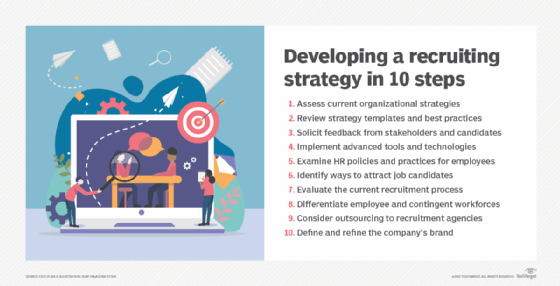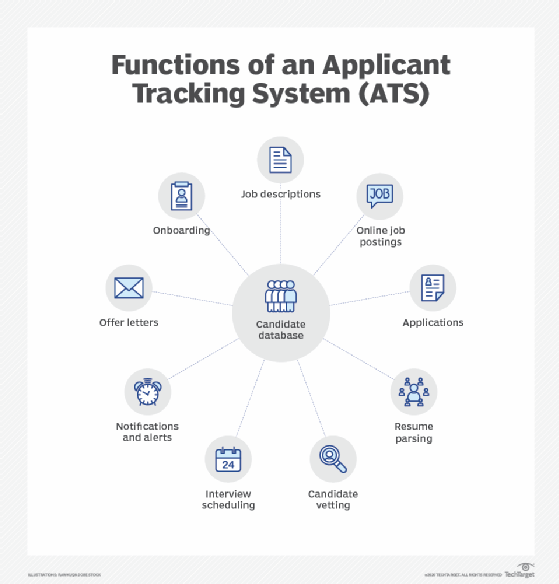Follow these 10 steps for a successful recruitment strategy
To attract the right job candidates, it's important to examine policies, solicit feedback, identify workforce gaps, deploy advanced technologies and promote the company brand.
Recruiting is a necessary function of any organization, regardless of its business model or industry.
To ensure that a company has an effective and efficient recruiting process to find the right candidates, the talent acquisition team must develop a recruitment strategy and plan.
What is a recruitment strategy?
A recruitment strategy is focused on the long term rather than specific hiring needs. Because of this, the strategy might have to change based on global socioeconomic factors. The strategy highlights how the company intends to recruit for open positions overall, when positions should be outsourced, the use of technology and social media, and internal mobility. It might also include information about hiring a diverse workforce, employer branding and how open positions are prioritized.
Then, a recruitment plan is developed that indicates how the strategy will be implemented. For example, the strategy might make internal hiring a priority. The recruitment plan identifies the specific steps, polices, program design, timelines and resources needed to make internal hiring a reality.
Why is having a recruitment strategy important?
The recruitment strategy helps the talent acquisition team know where to focus its attention, which is especially important when there are competing demands. The strategy also informs the HR team and managers about the big picture for recruitment and how the talent acquisition team is prepared to help the company meet its hiring needs.
This article is part of
Ultimate guide to recruitment and talent acquisition
What should a recruitment plan include?
A recruitment plan outlines how the company approaches the recruitment process and what recruitment tools are used in the short to medium term. Although the plan gets built after the recruitment strategy and is more specific, it still applies to all positions in the company that have to be recruited and isn't meant to provide details of each job requisition. Items that apply broadly to the recruitment function include the systems that are used, the vendors contracted to provide background checks, how the company's website is configured to showcase open positions, the processes to follow during recruitment and where candidates are sourced from.
The plan might include subplans for large groups of people with similar roles, such as industrial jobs that require certain steps to attract people in that industry, as opposed to office workers.
The plan might also include budget information and workforce plans so that the talent acquisition team members can prepare for future hires.
As talent acquisition works with hiring managers on new requisitions, they may develop specific hiring plans and strategies to fill each position, such as such as the tactics that may be used to source candidates for the position.
What are the benefits of having a strong recruitment strategy and plan?
A well-planned recruitment strategy does the following:
- Aligns recruitment efforts with company goals. The recruitment strategy and associated plan help direct the work of the recruitment team by focusing on attracting and hiring people in the areas most needed by the company -- for example, looking for candidates in new locations in which the company plans to expand.
- Helps establish a flexible budget for the plan. A budget can be written to support the recruitment strategy and provide backup support if additional money is required -- for example, upgrading the process with a new applicant tracking system (ATS).
- Refines and improves hiring practices. A repeatable process for attracting, interviewing and rating candidates can help identify top candidates more quickly, reduce bias and be adjusted over time.
- Saves time. A refined and uniform recruitment process identifies key components to ensure the right recruitment tools are in place for recruiters to use for every new job posting.
- Builds and targets a talent pipeline. Recruiters better understand the areas of the company that are growing and the types of skills required, as well as select the most worthwhile networking events and sponsorships that help build the targeted talent pipeline.
How to define the goals of a recruitment plan
For the talent acquisition team to validate that it is meeting the hiring needs of the company and hiring managers, the recruitment plan must include measurable goals. The goals should focus on activities that are in the control of the talent acquisition team. For example, time to hire is often used as a measure, but it can be affected by delays caused by people outside the talent acquisition team. Another example is the number of declined offers. Depending on the reason the candidate gave, such as the salary being too low, the metric might not be under the direct control of talent acquisition, but rather the hiring manager or finance department.
Other useful metrics and goals include the following:
- Actual vs. budgeted expenses.
- Feedback on the recruitment process.
- Number of qualified candidates passed to the hiring manager.
- Number of leads gathered from networking events.

Effective recruitment strategies follow these 10 steps
Formulating a viable recruitment strategy requires assessing current corporate processes, reviewing internal documents, gathering feedback, implementing technologies, evaluating workforce needs and defining the employer brand and culture. It specifically involves taking the following steps.
1. Assess current organizational strategies
Before developing a recruiting strategy, review existing corporate strategies that apply to recruiting, including the overall business strategy, current recruiting strategy and departmental strategies. Also, gather relevant information from the company's workforce plan.
These documents can provide key details, such as needed skills and corporate priorities, and validate compensation levels. The workforce plan might also include a calendar of key recruitment events to be held in busy times of the year -- for example, recruiting students in the summer or when there's a significant increase in the need for temporary workers.
In addition, review departmental budgets for recruiting and various online platforms, like LinkedIn and Glassdoor, to search for ideal candidates.
2. Review strategy templates and best practices
Numerous recruitment strategy templates and best practice lists are available online. Review them to see what other companies are doing and what can be applied to the organization. Each organization is unique, however, and any best practice should be customized to fit the organization's brand.
3. Solicit feedback from stakeholders and candidates
Gather and incorporate stakeholder feedback from hiring managers, executives, employees and HR teams, as well as job candidates.
4. Implement advanced tools and technologies
Small companies might rely on a manual process, but specialized software is often necessary as the recruitment volume increases. There are many options to consider when it comes to recruitment applications. An HR management system often includes a recruitment module with basic functionality to automate recruiting processes. In addition, some vendors specialize in developing ATSes that offer more advanced functionality. Consider the following technologies:
- AI tools can help target potential candidates with job ads, prescreen and rank resumes for review, assist with interviews and measuring candidate responses, and answer questions from candidates through a chatbot. ATSes can also use AI to build a more comprehensive view of candidates by pulling data from social media and websites.
- Resume-parsing tools automatically read resumes submitted by candidates and place the data in the right fields in the recruiting system -- for example, they put the education information on a resume in the ATS' education field. At the start of the hiring process, this capability can eliminate the need to open each resume individually and enables keyword searches across all candidates.
- Video interviewing software can be standalone or part of the ATS. It eliminates the need for in-person interviews, facilitates team interviews and makes it possible to interview qualified candidates face to face, regardless of their location.
- Job boards at sites like LinkedIn and Glassdoor expand an organization's search capabilities. Since they often cost money, it's important to capture and analyze where applicants are finding job postings to determine, for example, which job boards are geared toward permanent professional positions and which are better for attracting temporary help.
- Onboarding is an extension of the recruiting process and can improve a new hire's overall experience with the organization. Adding an onboarding module to the HR system or ATS automates the distribution and signing of policies and forms. It also helps new employees learn about the company.

5. Examine HR policies and practices for employees
The company's policies and practices concerning benefits, vacation policies, corporate social responsibility, professional development and flexible work options can provide an edge when competing for top talent.
Also, examine the interview process itself -- for example, whether phone screening is used for the first interview or if interview teams handle all positions or only those above a certain level. Take a look, too, at the timing and types of background checks to be conducted and by whom. This review of the hiring process might reveal outdated policies that are turning off candidates.
6. Identify ways to attract job candidates
Many methods are available to increase the talent pipeline and attract both active and passive job seekers. Prepare a communication channel to identify the ideal forums for a particular open role, create an engaging social media campaign that attracts candidates and validate effectiveness with metrics. What works for one role may be entirely different for another.
Posting open positions on the company website gives candidates a degree of familiarity with the corporate culture and what it has to offer. Other options include posting to job boards, offering an employee referral program, contacting past employees, manually searching for passive candidates, reviewing existing talent pools in the ATS, outsourcing to a third party and hosting internal business events. Posting open positions in specific locations, such as organization sites that help those in underrepresented communities find employment opportunities, can help attract diverse candidates.
Also, consider advertising open roles. When using job boards, decide whether the advertisement applies to all job postings or only those in a certain category, and determine whether to allow candidates to text their applications for roles that typically have high turnover rates. In addition, consider whether to market open positions. Determine, for example, whether to use video to make postings more attractive to candidates or develop a more sophisticated template to market open positions instead of simply posting job descriptions.
7. Evaluate the current recruitment process
Regularly evaluating the company's recruitment process ensures the program's practices and procedures remain effective. It's also critical to consider the process in terms of the candidate experience. The recruitment team should walk through all the steps a candidate might take when considering a position in the organization. Seek feedback from candidates and hiring managers in the spirit of continuous improvement.
8. Differentiate employee and contingent workforces
Depending on an organization's business requirements, an HR recruiting strategy may also have to take into account whether the talent search specifies permanent employees or contingent workers. Consider enlisting a third-party search agency to recruit contingent workers since they often can draw from an existing pool of talent.
Another consideration is whether the company develops employees internally to fill future vacancies or hires candidates externally. Both approaches have advantages and disadvantages, including the following:
- Existing employees are a known quantity. Skills, abilities and work ethic can be readily evaluated in an employee's current role, but extensive training might be needed to step into a new position outside their area of expertise.
- External candidates hired for specific skill sets can step into a position with little or no downtime but may not adapt to the company's culture, and their hiring might discourage current employees from seeking new opportunities in the organization.
9. Consider outsourcing to recruitment agencies
There are many outsourcing options for recruiting. The company's internal talent acquisition team can handle the day-to-day recruitment process, but consider partnering with a third-party agency for special recruiting situations. It may be more expedient and cost-effective, for example, to hire specialized recruitment agencies to handle a one-time need for a large number of workers with the same skill sets. Another scenario might be to build long-term partnerships with third-party recruiters, regardless of circumstance, while retaining some recruitment in-house.
10. Define and refine the company's brand
An employer's brand can significantly influence the quantity and quality of candidates for open positions, as well as employee perceptions of the company. A strong brand can be a big help in the recruiting process. Defining and refining a brand that's not well known, for example, should be an important component of a company's overall marketing and recruiting strategies. Also, consider using company review platforms, such as Glassdoor.
Stepping up recruiting efforts
Recruiting and placing the right people in the right roles at the right time remains a critical component, especially for enterprises that are juggling remote and hybrid workforces, battling to attract and retain highly skilled talent, and continuing to compete at a high level. Taking the time to follow these 10 guidelines can yield a strong recruitment strategy and ensure the talent acquisition team is focused on high-priority work and aligned with the company's goals, policies and hiring needs.
Eric St-Jean is an independent consultant with a particular focus on HR technology, project management and Microsoft Excel training and automation. He writes about numerous business and technology areas.








